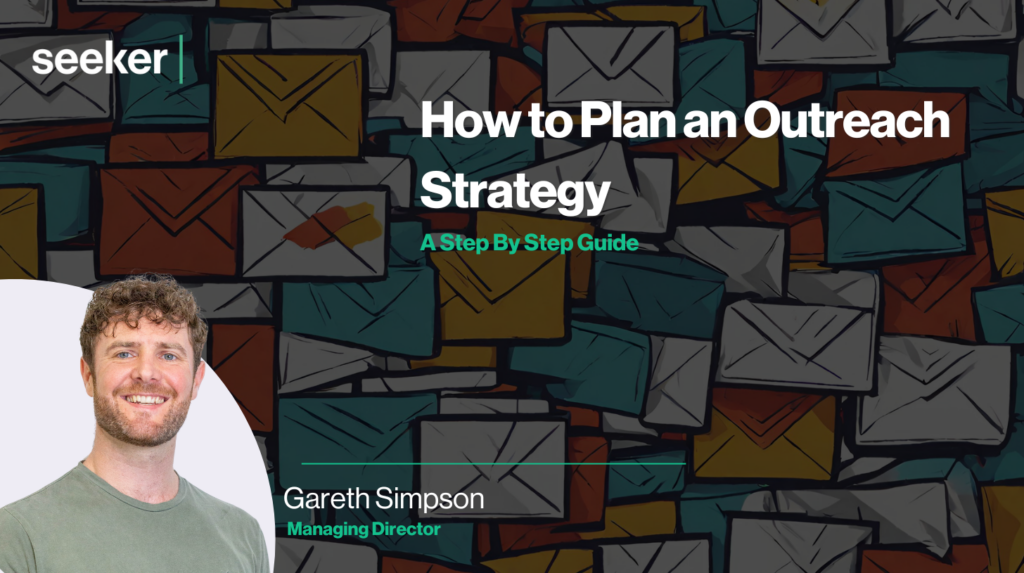
Building a successful SEO outreach campaign from the ground up is no mean feat. Winning high-quality backlinks on authoritative websites doesn’t happen overnight, and the process demands a combination of precision, creativity, and, perhaps most important of all — persistence.
Whether you’re a novice looking to add to your foundational knowledge. or you’re an outreach expert seeking further guidance, this guide should prove super valuable.
Below, you’ll find a whole load of tips and tricks for supercharging your outreach efforts, securing awesome coverage, boosting your brand’s buzz on social media, and fuelling your success in the SERPs (search engine results pages).
Types of marketing outreach campaigns
Before we dive into how to plan your outreach strategy, let’s discuss the forms your campaign could take. There are all sorts of creative ways you can win links, but every journey starts with a single step… Below, we’ll detail some of our preferred methods for building brand awareness.
What is PR outreach?
PR outreach involves establishing connections with journalists, media outlets, and influencers to promote and gain coverage for your client or brand. The goal is to secure positive press coverage, mentions, or features in reputable publications.
Example: Consider you’re the marketing manager for a tech startup about to launch a groundbreaking app. In your PR outreach efforts, you identify key journalists and tech influencers covering app development and innovation.
You reach out with personalised pitches, offering them exclusive access to a pre-launch demo of your app. To sweeten the deal, you provide them with a pre-prepared press release, detailing all of its most innovative features. The article is published in a leading technology magazine, providing your startup with valuable exposure and credibility in the industry.
What is blogger outreach?
Blogger outreach is all about connecting with the most influential content creators within your chosen niche. This method involves building ongoing relationships, and often these partnerships will be mutually beneficial, involving link exchanges or product samples. Your aim? To integrate your brand seamlessly into the blogger’s content.
Example: Imagine you run a skincare brand, and you’ve identified a popular beauty blogger known for in-depth product reviews. You initiate a blogger outreach campaign by sending a personalised email expressing your admiration for their content and explaining how your new skincare line aligns with their audience’s interests.
In this collaboration, you offer to provide them with exclusive access to your latest products for a detailed review. The blogger, in turn, receives valuable content for their audience and gains firsthand experience with your products. As a result, your brand seamlessly integrates into their content, reaching a wider audience and potentially earning a backlink in the process.
What is link-building outreach?
Let’s be clear here — link-building outreach is a bit of a catch-all term. Both blogger outreach and PR outreach could fall under the link-building outreach umbrella. However, while press release outreach and blogger outreach may aim to build brand awareness, they might not necessarily build a brand’s backlink profile. Here, the primary objective is to enhance your website’s authority and visibility in search engines by securing relevant and contextually valuable links from other websites.
Example: Suppose you’ve created a comprehensive guide on sustainable living practices, and you want to build authoritative backlinks to enhance your website’s SEO. Your link-building outreach involves identifying websites and blogs within the environmental and lifestyle niche.
You reach out to these websites with personalized emails, explaining the value of your guide and how it can complement their existing content. By offering them a unique and informative resource, you aim to secure contextual links within their relevant articles. The result is not only increased visibility for your content but also the acquisition of high-quality backlinks that strengthen your website’s authority in the eyes of search engines.
1: Get a feel for the current situation
Start by analysing your client’s current situation. Assess and record a baseline of key metrics so you can identify what the campaign objectives should be and track the success of the campaign.
The metrics you choose to record will differ from client to client. However, for us outreachers, common metrics include:
- Keywords
- Rankings
- Traffic
- Backlink profile
- Conversion rate
- Revenue
- Transactions
- Social engagement
- Brand awareness/press coverage
Also, analyse the brand as a whole by adopting the SWOT marketing methodology — this covers strengths, weaknesses, opportunities, and threats. Consider, for example, what are the brand’s USPs, what should the brand (or your outreach team) avoid referencing, what trends can you jump on for this brand, and what are the competitors doing?
On that note, you should also conduct a thorough competitor scrape, cross-referencing the metrics you will measure with the client’s main competitors. This will give you a thorough understanding of where the brand resides in the industry, and what you must do to help them move or stay ahead of the curve.
To make sure you’ve covered all bases, you may also like to conduct a PESTLE analysis to gain a wider overview of opportunities and threats to the client.
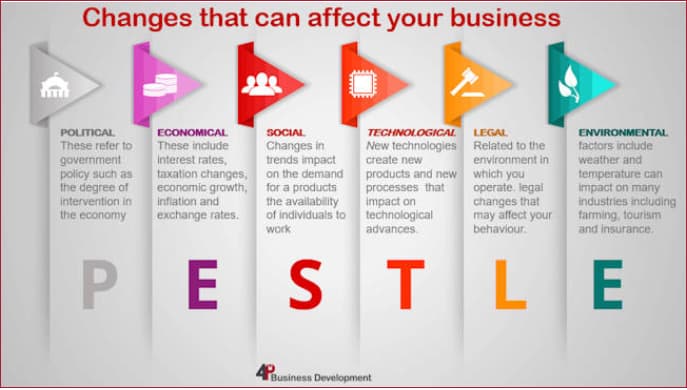
Credit: 4P Business Development
2: Define your SEO outreach campaign objectives
Once you have assessed the situation, it’s time to identify your outreach campaign’s objectives. Some clients may hand you very specific goals — they might want you to increase their number of backlinks by 20% for example — while others might give you more general aims and desires.
It’s down to you and your outreach team to iron out these aims to keep your client’s expectations in check — otherwise, you may be in for a difficult conversation at the end of the campaign when they are unfulfilled.
For success, make each objective SMART:
- Specific: Is the goal clear, precise, and unambiguous?
- Measurable: Does the objective say what success looks like? Can you measure whether this goal has been met qualitatively or quantitatively?
- Achievable: Is the objective possible based on the timeframe, resources, and support available?
- Relevant: Is this goal relevant to what the client wants to achieve?
- Time-based: Have you set a realistic deadline that’s relevant to the campaign?
Breaking down your objectives by timeframe is extremely important when it comes to outreach. If you’re link building, for example, it can take up to 10 weeks to witness one rank jump; the Google search algorithm doesn’t register changes instantaneously.
So if you’re targeting a handful of keywords one month, you may not see the true success of that month’s campaign until two months later. Unfortunately, search engines are a little slow on the uptake; this is simply something you’ll have to accept!
Define your main, overarching goals for the client that span a 6 or 12-month period. For example, rather than setting the outreach goal as ‘getting more backlinks to improve rankings’, an example of a SMART goal could be:
- Increase the backlink profile from 10k to 12k at the end of the six-month period.
- Move X keywords from page 4 to page 1 by the end of the six month period.
Once you have your umbrella objectives, set out your monthly objectives for each mini-campaign. Now you’re ready to start planning your strategy to obtain each goal.
3: Form your “big picture” strategy
The strategy for achieving your client’s goals is the largest part of planning an outreach campaign. At a previous BrightonSEO event, Georgina Park explained that it’s best to split it into two sections: the big picture of the strategy and the tactics.
When composing your big picture, gather your situational analysis to work out how you will meet your objectives. You should use the marketing principle STP here. This covers three key areas, including:
- Segmentation: Break your market down by age, location, etc. and identify their pain points.
- Targeting: Of the segments you’ve identified, how will you target them? Are there gaps in the market you can exploit?
- Positioning: How will you communicate your message to the segments to achieve your objectives?
The STP marketing approach focuses entirely on the target audience, which is key when it comes to outreach. After all, if you’re link-building, you’re essentially asking website owners to do you a favour by writing about (and linking to) your client. But if you can make your pitch using STP, your product will seem much more attractive.
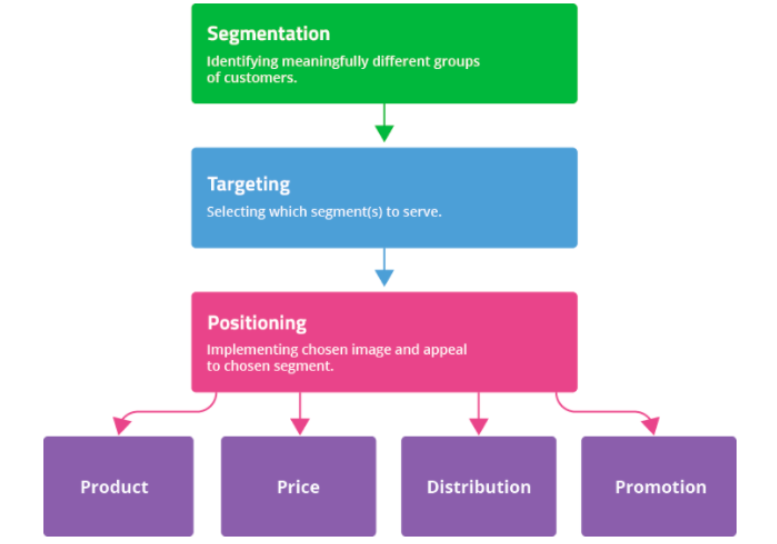
Credit: Pinterest
While STP relates directly to marketing campaigns, we can use the analysis to influence our outreach strategy by pairing them with great talking points from two other BrightonSEO speakers:
Segmentation
Begin by determining your target audience for outreach – not everyone will find your client and their product relevant. Consider the specific niches that align with your client’s offerings. For instance, if your client is in the sports industry, potential target niches could include sports, health, lifestyle, and, potentially, the tech sector.
Then build a picture of your segments demographically, focusing on personal attributes such as age and gender. Also, consider geography and prospect sites and brands’ missions and values.
You might also like to segment based on metrics relating to your SEO strategy, like DA, TF, DR, organic traffic, and keywords.
Example: Let’s say your client is a company that specializes in eco-friendly athletic wear within the sports industry. Your segmentation strategy would involve identifying environmentally conscious segments within your target audience. This could include individuals aged 25-40 who are interested in sustainable living, fitness enthusiasts who prioritize eco-friendly products, and those located in regions with a strong emphasis on environmental initiatives.
Additionally, you may segment based on metrics relevant to your SEO strategy, such as targeting websites with a high Domain Authority (DA) that align with the eco-friendly and sports lifestyle niche. This approach ensures that your outreach efforts are directed towards audiences and platforms that are most likely to resonate with your client’s brand.
Targeting
Then you need to think about how you will target the people you want to outreach to. Not in terms of how you’ll make contact (although, more on that later), but in terms of what segments are the best to target.
Evaluate the profitability of each segment and consider which one will bring the most value to your objectives. Also, think about the size and potential growth of each segment.
Keep in mind that bloggers swap brand details. Therefore, if you were to target one small sample of this community, it’s likely you’ll experience a wave of referrals off the back of your successful outreach.
The referrals are clearly extremely valuable as they will save you time sending out your next batch of outreach. You may want to prioritise targeting this segment as it could bring you more ROI.
Example: Continuing with the eco-friendly athletic wear example, your targeting strategy might involve prioritizing outreach to influencers and bloggers within the sustainability and fitness community. These segments could offer high profitability, given their alignment with your client’s brand values.
Additionally, considering the interconnected nature of the blogger community, focusing on a small but influential sample within this segment can lead to a ripple effect of referrals. Successful outreach within this community could result in bloggers sharing your brand details with their peers, creating a network effect that amplifies your outreach efforts and potentially brings more valuable opportunities for collaboration.
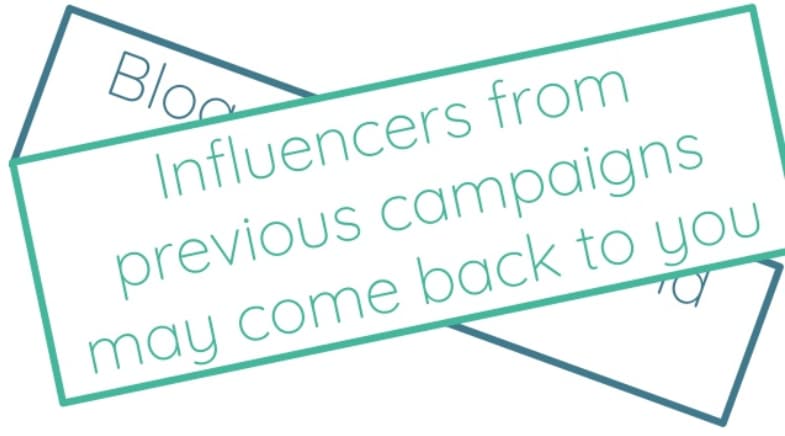
Credit: Slideshare
Positioning
When evaluating your target markets, also carefully evaluate how you can service each of these segments so that your outreach converts.
Most, if not all, of your target markets wish to be serviced via a payment. But think about how you can go one step further to cement a conversion. For example, full-time bloggers value timely payments, samples, and repeat work, whereas news outlets value relevant, exclusive content.
Then think about how you will angle your proposition so that it speaks louder than the noise of competitors and other outreachers. You might like to consider your method of outreach or your pitch, for example.
Example: Let’s say you are reaching out to two segments within the eco-friendly athletic wear market: full-time bloggers and news outlets.
For full-time bloggers, your positioning strategy might involve offering not only timely payments for collaborations but also providing them with exclusive access to new product launches and a consistent stream of eco-friendly samples. This goes beyond a simple transactional relationship, establishing a rapport with bloggers who appreciate timely compensation and the opportunity to regularly feature your innovative products.
On the other hand, when positioning your outreach to news outlets, the emphasis could be on delivering relevant and exclusive content. You might tailor your pitch to showcase the unique aspects of your client’s eco-friendly athletic wear, emphasizing its impact on sustainable living and the environment. This positions your brand as a thought leader and provider of exclusive content, making it more appealing amidst the competitive landscape of news outlets and ensuring that your outreach efforts convert effectively.
The inverted pyramid
One of the essential ways to secure a link with journalists is by writing the news for them and delivering it to them in the correct way. To do this, you’ll need to use what’s known as the inverted pyramid (pictured below).
Top outreach mistakes include sending the release as a PDF, including too much marketing speak, sending the story too far down the email, and writing a release that has a tenuous connection with the news. Do any of these, and your release will end up in a black hole.
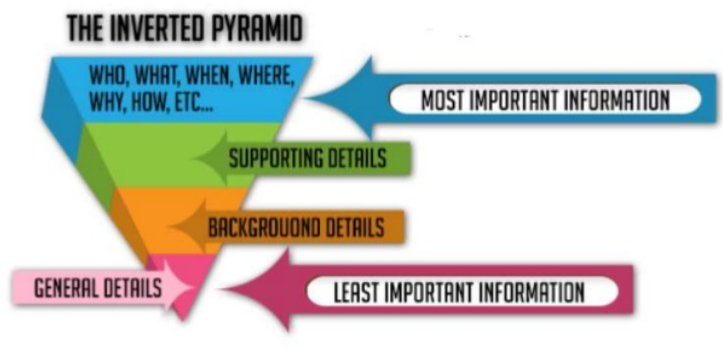
Credit: Slideshare
The STP marketing model can also be flipped to analyse your target outreach market. However, when building an outreach strategy, there are other questions to ask and topics to consider to work out how you will meet your objectives, such as:
- How will you get your client where they want to be? Eg. on page one for X keyword.
- How will you deliver those results from your objectives? Eg. looking at keyword rankings, traffic, and revenue.
- What is your overall intention? Eg. to increase the client’s organic traffic.
- How does your action plan look against the client’s competitors? Eg. competitors have coverage in X publications, so we need to target those.
4: Identify your outreach tactics
Once you have your strategy mapped out, it’s time to get to the nitty-gritty: how exactly will you get there?
In every marketing plan, this section normally follows the 7 Ps of marketing: price, product, place, promotion, people, processes, and physical evidence.

Credit: Smart Insights
Once again, not every P is relevant to an outreach campaign, but we can use them to influence our tactics.
Once again, not every P is relevant to an outreach campaign, but we can use them to influence our tactics.
Your client’s product
Ultimately, your client is the product you are selling, but they may have a product of their own that they want to push, especially if they are involved in the digital sphere.
Spend some time getting to know exactly what you are selling to your target market, whether that be your client on the whole, the client’s product, a feature, a press release, or a link.
Price and budget
For us outreachers, there is a whole range of pricing aspects to consider, from what your budget is and how far it should stretch, to what a link, article, or social shout-out is worth and product and sample fees.
Weigh up every aspect of your pricing strategy for the overall campaign, and month-by-month if you need to, keeping your objectives and your segments in mind.
Butcher suggests that where money is involved with bloggers and influencers, always make a contract. Cover the payment, deliverables, and deadlines to ensure you manage expectations and can run the campaign smoothly.
Promotion
In a standard marketing campaign, the promotion covers the tools that should be used to promote a product or service, such as PR, sales advertising, and social media.
But when planning an outreach strategy, you need to look at the promotion concept differently, as we already know that our task as outreachers is to promote the product via PR, SEO, social media, or a mixture of all three.
Instead, treat the promotional part of the tactics as how you will communicate with your segments. For most of us, email is the tool of choice, especially for a large-scale campaign. However, social media is a common way to chat with influencers, especially over Twitter. Use the right tool to communicate the right message.
While outreachers from PR, SEO, and social media agencies tend to adopt a mass email approach because of the large volume of outreach required per campaign, it’s also rather risky. That’s because maintaining it can be difficult, especially when reaching out to hundreds of prospects at a time. As a result, many emails are left unanswered which could damage the client or agency’s reputation.
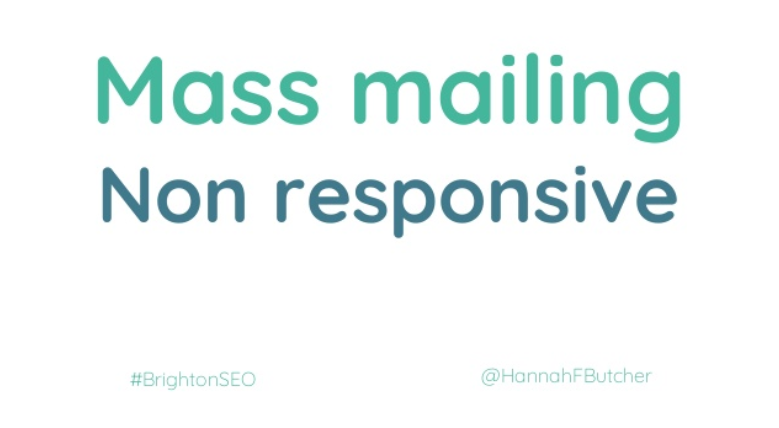
Credit: Slideshare
I’m going to introduce my own P to the mix: the pitch. If you want to reach out to sites you have no existing relationship with, a cold-call email is a great option. However, like there’s a science to outreach, there’s a science behind a cracking cold-contact email.
Research suggests that guest blogger or sponsored post outreach emails might expect a reply rate in the 5–15% range. It’s not bad, but it’s not great — especially if you’ve spent two hours crafting two killer templates.
Learning how to introduce yourself is the difference between influencers responding to your message and sending it to the trash with the rest of the poorly personalised boilerplate emails.
“I’m contacting you on behalf of a fashion brand” won’t fly with your prospects. There are many types of outreach services, such as PR, SEO, and social media, so tell the blogger exactly what you do so they can identify your aims from the get-go. This is guaranteed to reduce your email traffic and still get the responses you need.
As you might expect, the art of the outreach email is a hotly debated topic in the world of digital marketing, and it’s one we’ve covered in detail before — check out our recent rundown of the dos and don’ts of writing outreach emails, or our guide on Crafting Headlines & Subject Lines for a deeper dive on the subject.
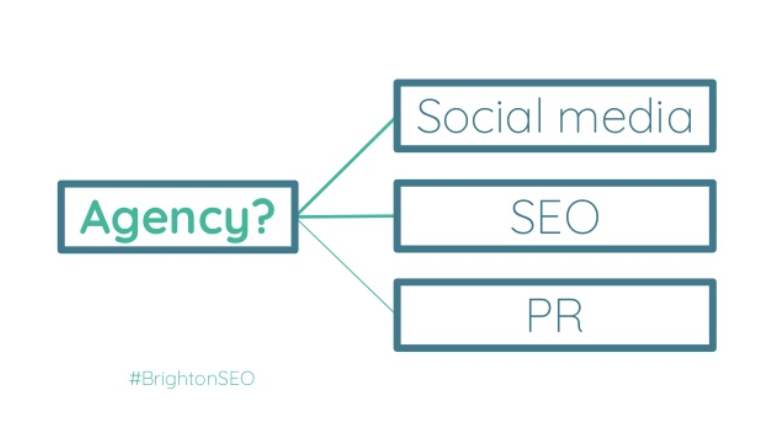
Credit: Slideshare
Particular details
I’m throwing in another of my own Ps into the mix to cover the remaining particular details. As an outreacher, from a PR, SEO, or social media agency, you will have a fair idea of what you need to do to achieve your SMART objectives. This could cover targeting certain pages or keywords, or pulling together some press releases for up-and-coming events.
Iron out the remaining details you need to launch your campaign, like a link-building strategy or a content plan, for example. Keep your situational analysis and objectives in mind at all times.
The appropriate people
The last P of the marketing mix that is most pertinent to your outreach strategy is people. Work out who will be responsible for each element of the campaign to make your tactics happen, and if needs be, don’t shy away from collaborate with other departments! Consider any skills gaps, who is the most qualified, and sign-off authorities.
5: Get this plan into action
Once you’ve got your tactics in place, draw up a schedule to implement them. Review responsibilities and structures, processes and systems, and internal resources and skills.
Having a Gantt chart that clearly displays the steps your outreach team will take is extremely beneficial. Top-level, it should detail the process, timescale, task delegation, and budget. But ultimately, it will guide your outreach team through the campaign from start to finish.
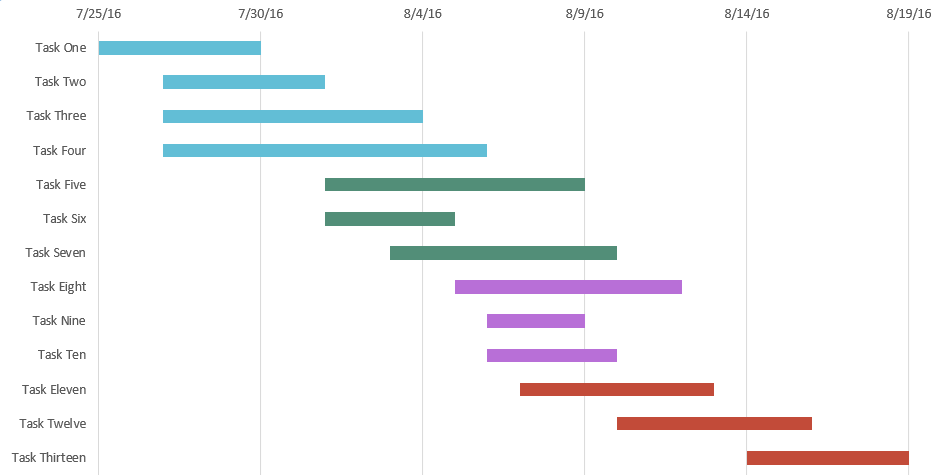
Credit: Teamgantt
6: Measure your success
The final stage of planning your outreach campaign is your control or measuring the success of your campaign. The metrics should be pertinent to you and your client and should relate directly to the client’s KPIs and SMART objectives.
Consider the tools and reporting platforms you need to report, who is responsible for documentation, the frequency of reporting, the review of measurements, and any actions on variance.
Whether you’re from an SEO, PR, or social media agency, you should have a fairly good idea of how to construct a successful outreach strategy. Got a question about outreach, SEO, or digital marketing strategies? Contact our team of specialists today — we’re always up for a chinwag!
Got a question about outreach, SEO, or digital marketing strategies? Ask Laura in the comments below.
